Plasmodium berghei bio-burden correlates with parasite lactate dehydrogenase: application to murine Plasmodium diagnostics
- PMID: 26729268
- PMCID: PMC4700574
- DOI: 10.1186/s12936-015-1027-2
Plasmodium berghei bio-burden correlates with parasite lactate dehydrogenase: application to murine Plasmodium diagnostics
Abstract
Background: The spectrum of techniques to detect malaria parasites in whole blood is limited to measuring parasites in circulation. One approach that is currently used to enumerate total parasite bio-burden involves the use of bio-luminescent parasites. As an alternative approach, this study describes the use of a commercial ELISA human parasite lactate dehydrogenase (pLDH) detection kit to estimate total parasite bio-burden in murine malaria models.
Methods: The cross reactivity of pLDH in a commercial human malaria pLDH diagnostic kit was established in different components of blood for different murine malaria models. The use of pLDH as a measure of parasite bio-burden was evaluated by examining pLDH in relation to peripheral blood parasitaemia as determined by microscopy and calculating total parasite bio-burden using a bio-luminescent Plasmodium berghei ANKA luciferase parasite.
Results: The pLDH antigen was detected in all four murine Plasmodium species and in all components of Plasmodium-infected blood. A significant correlation (r = 0.6922, P value <0.0001) was observed between total parasite bio-burden, measured as log average radiance, and concentration of pLDH units.
Conclusions: This high throughput assay is a suitable measure of total parasite bio-burden in murine malaria infections. Unlike existing methods, it permits the estimation of both circulating and sequestered parasites, allowing a more accurate assessment of parasite bio-burden.
Figures
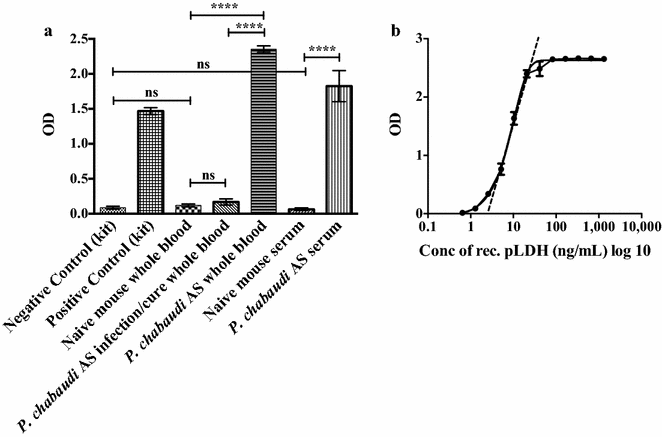

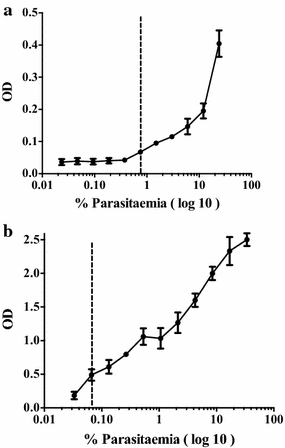
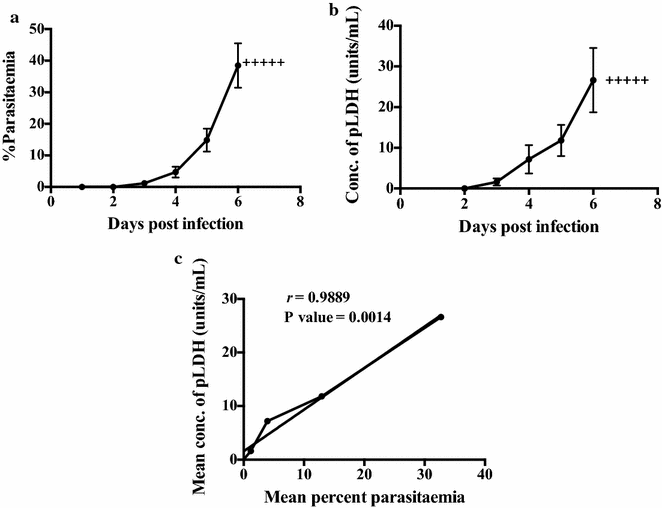
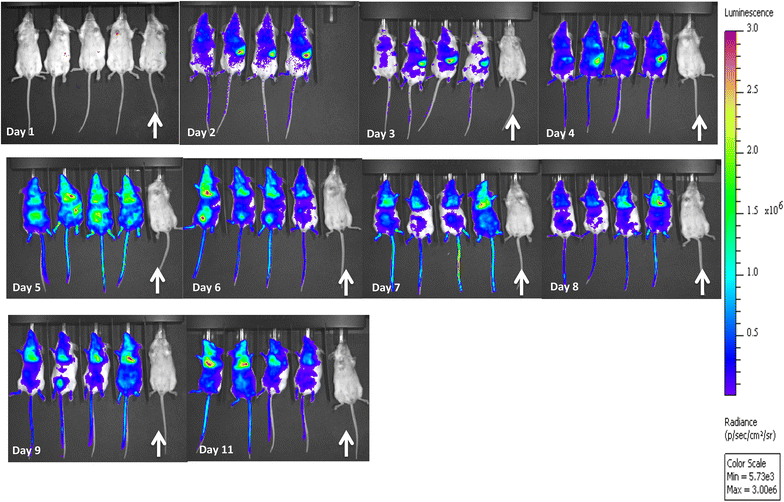
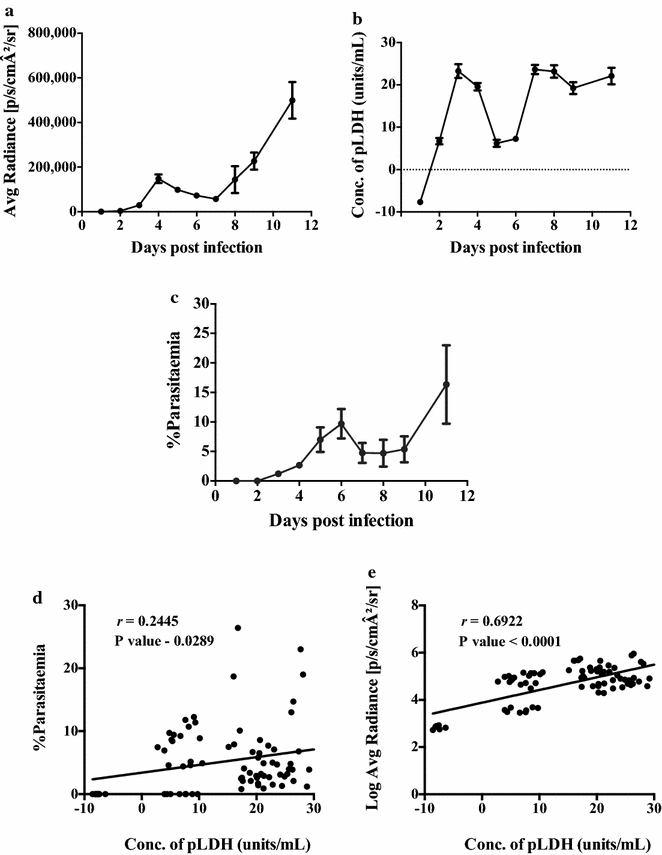
Similar articles
-
Comparative evaluation of a rapid diagnostic test, an antibody ELISA, and a pLDH ELISA in detecting asymptomatic malaria parasitaemia in blood donors in Buea, Cameroon.Infect Dis Poverty. 2017 Aug 1;6(1):103. doi: 10.1186/s40249-017-0314-2. Infect Dis Poverty. 2017. PMID: 28760158 Free PMC article.
-
Quantification of malaria antigens PfHRP2 and pLDH by quantitative suspension array technology in whole blood, dried blood spot and plasma.Malar J. 2020 Jan 9;19(1):12. doi: 10.1186/s12936-019-3083-5. Malar J. 2020. PMID: 31918718 Free PMC article.
-
The rodent malaria lactate dehydrogenase assay provides a high throughput solution for in vivo vaccine studies.Parasitol Int. 2015 Aug;64(4):60-3. doi: 10.1016/j.parint.2015.02.001. Epub 2015 Feb 19. Parasitol Int. 2015. PMID: 25701649
-
Exploring Biomarkers for Malaria: Advances in Early Detection and Asymptomatic Diagnosis.Biosensors (Basel). 2025 Feb 12;15(2):106. doi: 10.3390/bios15020106. Biosensors (Basel). 2025. PMID: 39997008 Free PMC article. Review.
-
[Advances in automatic detection technology for images of thin blood film of malaria parasite].Zhongguo Xue Xi Chong Bing Fang Zhi Za Zhi. 2017 May 5;29(3):388-392. doi: 10.16250/j.32.1374.2017015. Zhongguo Xue Xi Chong Bing Fang Zhi Za Zhi. 2017. PMID: 29469543 Review. Chinese.
Cited by
-
Assessment of false negative rates of lactate dehydrogenase-based malaria rapid diagnostic tests for Plasmodium ovale detection.PLoS Negl Trop Dis. 2019 Mar 11;13(3):e0007254. doi: 10.1371/journal.pntd.0007254. eCollection 2019 Mar. PLoS Negl Trop Dis. 2019. PMID: 30856189 Free PMC article.
-
Observation of the Gut Microbiota Profile in C57BL/6 Mice Induced by Plasmodium berghei ANKA Infection.Front Cell Infect Microbiol. 2021 Oct 28;11:680383. doi: 10.3389/fcimb.2021.680383. eCollection 2021. Front Cell Infect Microbiol. 2021. PMID: 34778098 Free PMC article.
-
Identification of adjuvants for clinical trials performed with Plasmodium falciparum AMA1 in rabbits.BMC Immunol. 2019 Jul 30;20(1):25. doi: 10.1186/s12865-019-0307-y. BMC Immunol. 2019. PMID: 31362695 Free PMC article.
-
Observation of the Gut Microbiota Profile in BALB/c Mice Induced by Plasmodium yoelii 17XL Infection.Front Microbiol. 2022 Mar 31;13:858897. doi: 10.3389/fmicb.2022.858897. eCollection 2022. Front Microbiol. 2022. PMID: 35432291 Free PMC article.
-
Poor performance of malaria rapid diagnostic tests for the detection of Plasmodium malariae among returned international travellers in China.Malar J. 2023 May 24;22(1):163. doi: 10.1186/s12936-023-04596-1. Malar J. 2023. PMID: 37226272 Free PMC article.
References
-
- WHO. World malaria report 2014. Geneva: World Health Organization; 2014, p. 242.
-
- Baird JK, Owusu Agyei S, Utz GC, Koram K, Barcus MJ, Jones TR, et al. Seasonal malaria attack rates in infants and young children in northern Ghana. Am J Trop Med Hyg. 2002;66:280–6. - PubMed
-
- Giemsa G, Werner A. Erfahrungen mit weiteren dem Chinin nahestehenden Alkaloiden und einigen ihrer Derivate bei Malaria (Chinidin, Hydrochinidin, Cinchonin, Hydrocinchonin, Cuprein, ChinSthylin und Chinpropylin) Archiv für Schiffs- und Tropenhygiene. 1914;18:12–15.
Publication types
MeSH terms
Substances
LinkOut - more resources
Full Text Sources
Other Literature Sources
Medical
Research Materials

